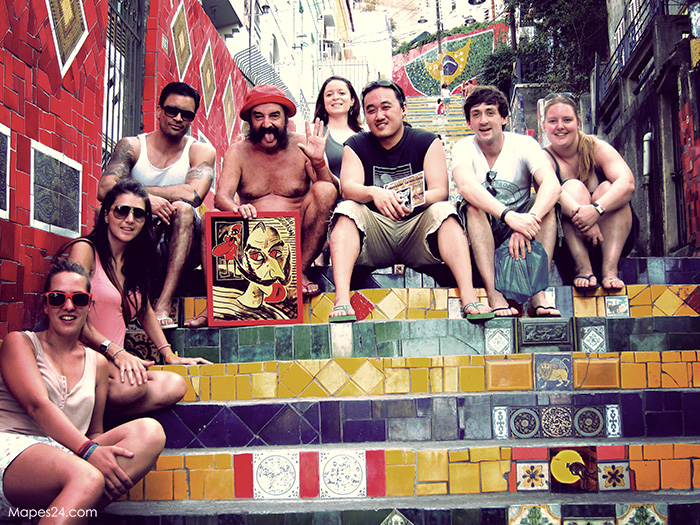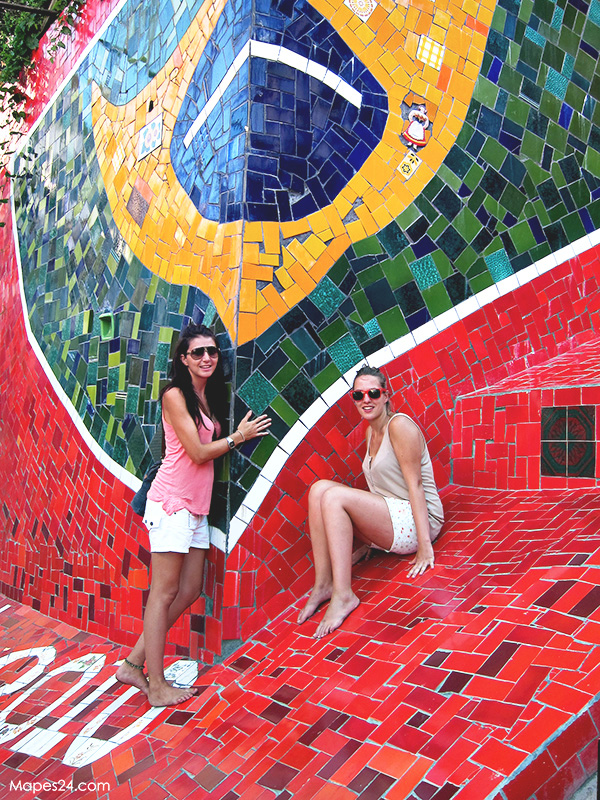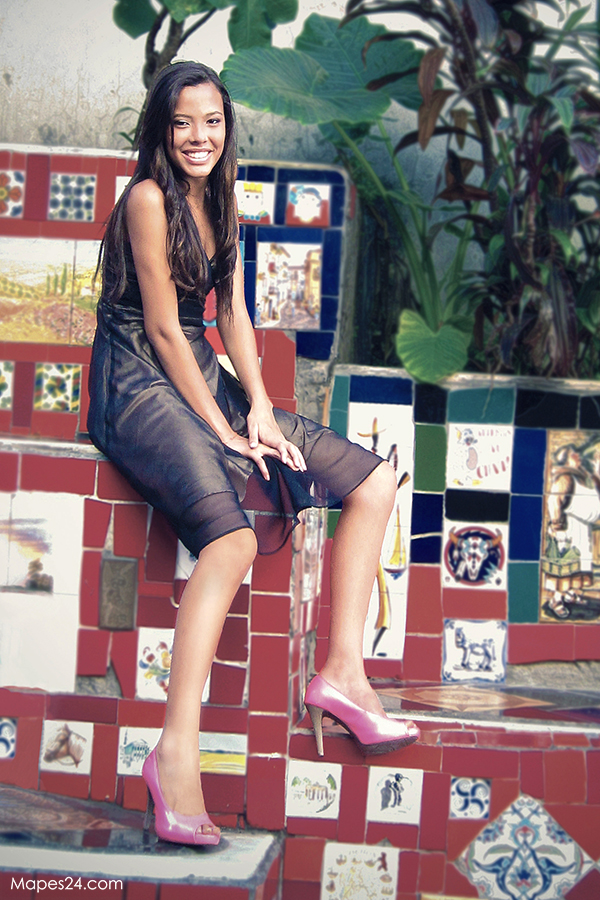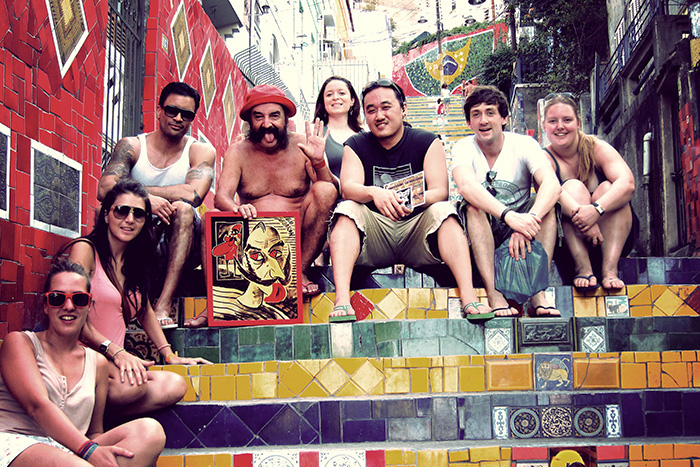I decided to write this post after recently coming across an article reporting on the death of Jorge Selarón.
Though you may not recognize his name, there’s a good chance that you have probably seen his most famous work, the Escadaria Selarón (aka Selaron Steps).

Sitting next to Selarón on his world-famous steps
Outside of the ‘Christ the Redeemer’ (Cristo Redentor) statue, Sugarloaf Mountain (Pão de Açúcar), and the beautiful beaches of Ipanema and Copacabana, one of the most instantly recognizable fixtures in Rio de Janeiro are the Escadaria Selarón. You may be familiar with the steps as they’ve been featured in music videos (U2, Snoop Dogg, and Flo Rida), print, and travel shows. They were also featured heavily in promoting the 2014 World Cup in Brazil, and the 2016 Rio Olympics.
What makes the 215 steps that connect the Lapa and Santa Teresa neighbourhoods in Rio de Janeiro truly unique, are the 2000+ tiles (collected from over 60 countries around the world) that cover the 410 foot long area.
 Chilean artist Jorge Selarón first moved into a house next to the stairs in the Lapa neighborhood of Rio de Janeiro in the 1980s. He had left his hometown at the age of 17 to travel to 57 countries, staying anywhere from a few weeks to a few years, before landing in Brazil in 1983. After living in Rio for 7 years, he began decorating the 215 dilapidated steps.
Chilean artist Jorge Selarón first moved into a house next to the stairs in the Lapa neighborhood of Rio de Janeiro in the 1980s. He had left his hometown at the age of 17 to travel to 57 countries, staying anywhere from a few weeks to a few years, before landing in Brazil in 1983. After living in Rio for 7 years, he began decorating the 215 dilapidated steps.
When his project began, he was consistently out of money, so Selarón sold paintings to fund his work and scavenged both tiles and porcelain from various construction sites and piles of urban waste found on the street of Rio. As word of his project began to spread, he began to accept tiles donated by friends and supporters from around the world.
His stairs were officially declared a city landmark in 2005, and were continuously worked on until his death in 2013.

Though most of the articles I’ve read have focused on the complicated circumstances of his death (possible murder vs suicide), I wanted to write about how the life of this unique artist has impacted my outlook regarding my own creative work.
Even though his art was in a different medium, there are many lessons I find that apply to my photography. When I met him a few years ago, much like many of his admirers, I found it quite easy to be in awe of Selarón due to the beauty and scope of his work, but it was only after delving into the life of the man, that I was able to extract the following important lessons:
YOU ARE NEVER TOO OLD TO BEGIN DEVELOPING THE CREATIVE IN YOU:
- Photography has been a hobby of mine ever since my parents bought me my first point & shoot film camera when I was 10, but I did not see it as the means to personal artist expression until I reached my mid-thirties. Like many of my elderly patients at the hospital who’ve expressed regret over not learning how to paint, draw, sing, play an instrument, etc. when they were younger, I had confined the art of learning to a certain age even though I was relatively young myself. What’s interesting is that Selarón did not begin work on his globally recognized art piece until the age of 43. Unless both feet are already in the grave, there is no reason why you can’t take at least one step today (no matter how small) towards learning the skills that allow you to express the creative in you.
DON’T USE TECHNOLOGY AS AN EXCUSE FOR WHY YOU CAN’T CREATE:
- This seems to apply more towards photographers that I’ve met, but I’ve lost track of the amount of times I’ve heard fellow photographers complain that they’re unable to produce their best work due to not owning the latest cameras “Mine only shoots 12 MP images”, “I don’t have 4K video”, or not having enough equipment “I probably could’ve taken some really nice headshots if I had a beauty dish”, and I admit that at times, I’ve felt the same. Selarón did not focus on what he didn’t have, instead, he went out and began his work using whatever items he had available to him at the time…even if it meant sifting through other people’s trash. This way of thinking frees me to focus on what I’m creating, rather than being confined by the process of how I’m going to create.
BE PATIENT AND ALLOW YOUR WORK THE OPPORTUNITY TO EVOLVE:
- It took 23 years for Selarón to transform those steps into what they are today, and here I am complaining about the fact that it’s taking more than a few weeks to fine-tune some of the concepts I have in my head for future projects. Imagine if he’d given himself a timeline of a few weeks, or a few months? Would the step be anywhere near as grand as what they are today?
DON’T BE AFRAID TO BE LED BY PASSION. BE IN LOVE WITH YOUR ART, EVEN IF NOBODY ELSE IS:
- As a creative, you’ll always find detractors in this society. People who don’t understand your vision, who don’t value art as they see it as “impractical”, or those who don’t respect the transformative value that is found in personal, creative expression. When Selarón first began, many of his neighbors couldn’t fathom the scope of his vision and often complained about the smallest details (he was initially mocked about the colors he’d used even though he based them on Brazil’s national flag). Even with a lack of support from those around him, he knew that he wanted to leave a “tribute to the Brazilian people”, and he didn’t allow those around him to stop him from doing so. We live in an odd time, where value is determined by “likes” and “views”, and I will find myself questioning the value of my own work when I don’t get the online response that I’d hoped for. Selarón reminds me that art is first and foremost an expression of one’s self, and will always have value even if it’s for the creator alone.


[…] https://mapes24.com/2015/09/22/lessons-learned-from-artist-jorge-selaron-on-the-steps-of-escadaria-se… […]
LikeLike
Wow! Lovely! So much color!
LikeLiked by 1 person
Totally agree – the last one is especially, sometimes we were worried too much with others opinions, like losing confidence even before presenting it to public. Great advice!
LikeLiked by 1 person
Thx Indah! Yeah, I know that I’ve personally hindered my own progression by caring too much about how others may perceive my work, especially when I was first starting out in photography. I luckily realized that as long as I can honestly feel that I’ve expressed myself to the best of my capabilities, that is all that really mattered.
Btw, you have great photos on your site. I especially love your underwater work! 🙂
LikeLike